Abstract
This research was based on a survey conducted in Bangladesh in three major seed-producing divisions, viz., Dhaka, Mymensingh, and Chittagong. Descriptive data was gathered by randomly selecting 100 peasants and 100 rural retailers for in-depth interviews. The general accounting approach was also used to assess profit and loss. The objective of the study was to analyze the marketing tendencies of vegetable seed farmers and sellers. The results showed a lack of market information, poor institutions and arrangements, poor marketing infrastructures, transportation system, and high and unfair profit margin distribution among the value chain actors with little share to the farmers in the vegetable seed market. These findings are indicators of poor marketing efficiency and thereby suboptimal operation of the seed marketing system. The significant determinants of market supply of vegetable seeds were found to be the average current price, age, the total size of land, farmers’ experience, sex, number of oxen, and access to market information. The determinants of demand for vegetable seeds—family size, purchase frequency, the average current price, income level, average expenditure on food and purchasing, profit or loss of vegetable seed farming—were found to be significant in the study. According to the findings of this report, vegetable seed sector in Bangladesh needs more government support, especially in terms of marketing policies in order to improve the current state of vegetable seed farming. Vegetable seed farming was not profitable due to a lack of technology and knowledge, as well as a lack of funding. With the existing status of infrastructure, the presence of middlemen is unavoidable. As a result, farmers have no alternative but to follow the orders of the middlemen, resulting in seed quality problems. Hence, the results are indicative of the measures that should be taken for production, market infrastructure, arrangements, and institutions to improve the functioning of the seed marketing system. It also proposes a vegetable seed distribution channel through which a cooperative community would serve as a collecting hub for a more efficient marketing scheme.
Keywords:
marketing system; structure; conduct; performance; channel; margin; market supply; market demand 1. Introduction
Bangladesh is a very small country of about 147,570 square kilometers in South Asia. More than 700 rivers render the soil of Bangladesh fertile. Furthermore, Bangladesh has the largest river delta in the world and is known as the basin of South Asia. These features provide opportunities to cultivate vegetables in Bangladesh. Seed marketing is one of the Bangladeshi farmers, retailers, and wholesalers’ business activities that are one of the most relevant, but still misunderstood. Seed marketing seeks to meet farmers’ needs for a consistent supply of improved seed varieties of high quality at a reasonable price. Vegetable seed farming provides ample employment opportunities to help raise the income of farming communities, and it also has tremendous potential to push overall agriculture growth [1]. According to the Ministry of Agriculture, production and distribution of quality seeds are insufficient in the public sector compared with demand [2]. An efficient marketing system plays an important role in economic development because it stimulates production, avoids unnecessary fluctuation in output and prices, and reduces the cost of production and unfair share of income. However, to attain these benefits, the marketing system and marketing technology have to keep pace with the production technology and socio-economic development of the country. The experience of many countries suggests that in the absence of an efficient marketing system, agricultural development cannot progress very far in stimulating production and contributing to price stability [3]. Lack of production, an insufficient supply of quality seeds, and poor governing structures have been identified, which contribute to poor marketing efficiency and thereby suboptimal operation of the marketing system [4]. It is important to improve the marketing system for vegetable seeds to attain better production in the country, which in turn also helps to maintain the quality of production for export. The private sector is the major player in the seed sector, dominated by hybrids [5]. Recently, efforts to export agricultural products may not be successful due to a lack of quality issue [6]. Improving the economic environment for vegetable seed production and distribution in Bangladesh is important for improving the standard of living of farmers and also for the economic development of Bangladesh. In contrast to the attention paid to other seed industry operations, the complexities of coordinating successful vegetable seed distribution systems, especially for small-scale farmers, have often been overlooked. The physical aspects of seed processing and storage have received more consideration and support than the difficult management problems inherent in overseeing sales and delivery. However, the actual conditions of production and distribution of vegetable seeds for the producers have not been clarified, hence the objectives of this study were:
- To examine the current marketing practices of vegetable seed farmers and sellers.
- To investigate the marketing behavioral inclinations of vegetable seed farmers and sellers.
- To analyze the profit-loss situation of vegetable seeds.
2. Materials and Methods
A field survey was conducted in the major farming communities in three of Bangladesh’s eight divisions in 2019: first Dhaka, followed by the Chittagong and Mymensingh divisions. Descriptive data were used in this study. We describe the vegetable seed sector and identify the issues relating to the marketing system. To help explain the factors relating to the marketing system of the vegetable seed sector in Bangladesh, we also conducted a thorough review of the literature. Data were collected using in-depth interviews with stakeholders, viz., peasants, and retailers. They were interviewed using a structured questionnaire for data collection. In each case, 100 peasants and 100 small retailers were chosen at random. Secondary data were collected from different sources such as stakeholders, line agencies, government organizations, NGOs, and INGOs. The collected data were tabulated, cross-tabulated, summarized, and analyzed using Microsoft Excel.
Here, average profit or loss of vegetable seeds farmer was determined by simple accounting formula: Average Profit/Loss = ASSP − ASPC = ASSP − (ANMC + AMCNM), where ASSP = Average seed selling price, ASPC = Average seed production cost, ANMC = Average nursery management cost, and AMCNM = Average manpower cost for nursery management. Firstly, selling price of selected vegetable seeds was gathered and calculated the average seed selling price. From the average seed selling price average nursery management and manpower cost were deducted to find the actual profit or loss of a seed farmer.
Lists of available vegetable and fruit seeds, as well as the districts where they are cultivated, are given below (Table 1). In Bangladesh’s three divisions, we can also get a view of the most widely grown vegetables seeds.

Table 1.
Bangladesh’s main production sites for varied vegetable seeds.
3. Results
3.1. Vegetable Seed Sellers
The results revealed that 32.5% of the vegetable seed sellers were aged 21–30 years (Figure 1), indicating that seeds are mostly sold by young people. It was found that the young businessperson has the ability to prepare adequate business plans for start-up assistance [7]. Thirty percent of the seed sellers have attained the Higher Secondary Certificate (HSC), the highest percentage compared with the other levels of education, and only 15% of the sellers were classified as illiterate (Figure 2). If this level of education continues, the future seed business can prove to be profitable, with young people being able to easily adopt new technologies [8]. Education enhances networking to sell seeds throughout the country.
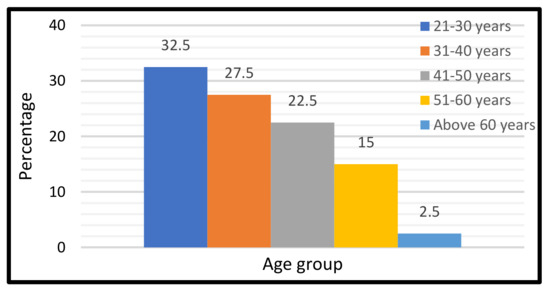
Figure 1.
Age distribution of the vegetable seed sellers.
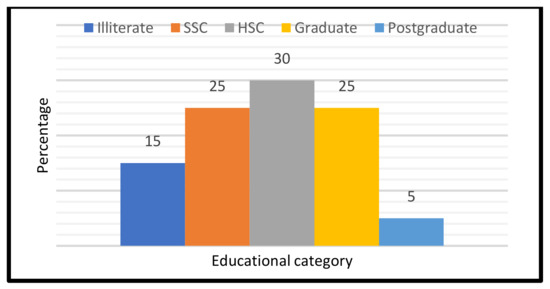
Figure 2.
Educational background of the vegetable seed sellers.
Eighty percent of the seed sellers are members of the Bangladesh Society of Seed Technology (BSST) (Figure 3), indicating that most of the retailers and wholesalers should be aware of seed quality, varieties, new technologies, availability, and production technology. Seed quality in agreement with the findings [9] of which implies the basic parts of the label and where to find them on the package. Most of the seed sellers have been members of BSST since 2005 (Figure 4), which implies that before 2005, seed sellers had less knowledge of the seed business. The turning point may have come about from government influence during that period.
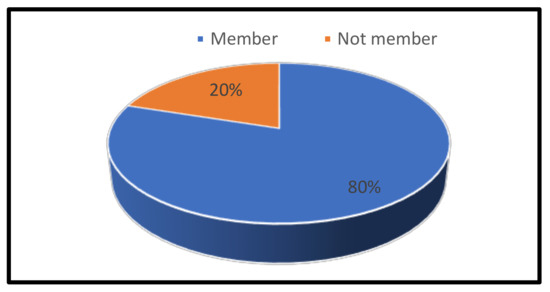
Figure 3.
Membership of Bangladesh Society of Seed Technology (BSST).
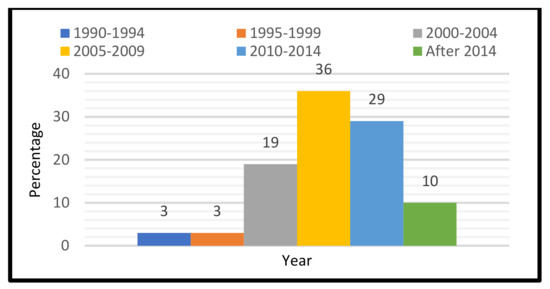
Figure 4.
Length of membership of BSST.
Ninety-five percent of the seed sellers are directly involved in the business (Figure 5), with fewer middlemen between the producers and buyers. Therefore, the retail price in the sellers’ private market lies within the bid-ask spread [10]. Most of the vegetable seed sellers have been involved in the seed selling business since 2000 (Figure 6), which is when government support of the seed business started. Membership of the BSST and the startup of seed businesses are positive indicators that the sellers are taking a more professional approach to the selling of quality seeds. Some important marketing policies for the seed marketers are selecting the main traits of seeds, branding particular seeds, packaging the seeds, labelling, and support services [11].

Figure 5.
Direct involvement in the vegetable seed business.

Figure 6.
Length of involvement in the vegetable seed business.
After buying seeds, the seed sellers incur expenses for transportation, grading, seed treatment, packaging, promotion, and other purposes. Of those expenses, most sellers bear the cost of transportation and packaging in both wholesale and retail businesses (Table 2). Transportation is one of the most expensive sectors in Bangladesh because of poor road infrastructure. Ultimately, this cost is included in the seed price. Additional expenses like transportation, cleaning and grading, seed treatment, packaging, and promotion depend on the supply chain of the wholesaler or retailer. Wholesalers need more storage facilities compared with retailers. On the other hand, retailers need to preserve seeds for a long time compared with wholesalers. Therefore, additional costs differ between wholesalers and retailers.

Table 2.
Additional expenses after buying seeds.
Thirty percent of the seed sellers are involved in the wholesale business (Figure 7). However, both wholesale and retail businesses (63%) were preferred by the seed sellers (Figure 7). Seed sellers used to buy from producers and middlemen, but 45% of seeds are collected from both seed producers and middlemen (Figure 8). The seed sellers cannot rely on seed producers or middlemen only, so both are necessary for the stability of their businesses. The seed sellers need to collect the seeds, which depends on their type of business. If the sellers are involved in the retail business, they collect seeds only from the middlemen, but if the business is wholesale or both, they need to collect seeds from seed producers and middlemen. Although the middlemen are often criticized, they also play key roles such as collecting, grading, storing, distributing, and selling in the vegetable seed marketing channels [12].
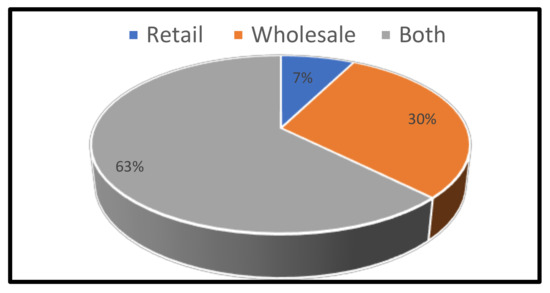
Figure 7.
Activities of the vegetable seed business.
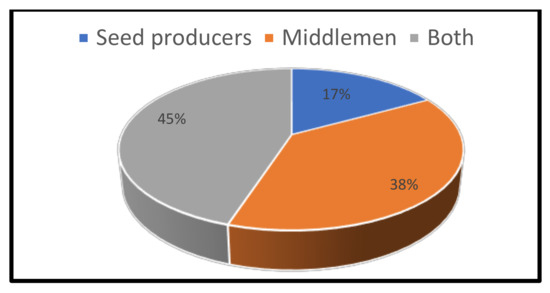
Figure 8.
Collection of vegetable seeds.
3.2. Vegetable Seed Farmers
Thirty-five percent of the vegetable seed farmers were aged 21–30 years, which indicates mostly young people are engaged in seed farming, followed by middle-aged people aged 41–50 years (27.5%) (Figure 9). In addition, the vast majority of vegetable seed farmers were male (97%), with very few females (3%) engaged in seed farming (Figure 10). Because religion and the social system are factors that affect women’s participation in agriculture, their participation is often underreported for cultural reasons [13].
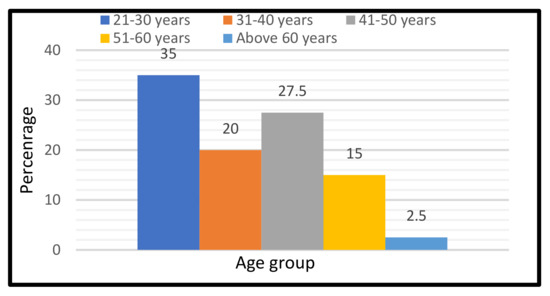
Figure 9.
Age distribution of the vegetable seed farmers.
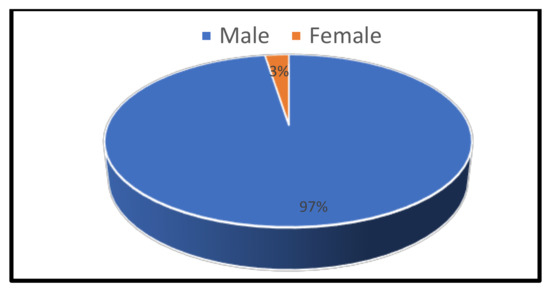
Figure 10.
Gender of the vegetable seed farmers.
The Figure 11 shows that 50% of the families of the seed farmers comprised 5–7 people. The greater number of family members the more people that can help with vegetable seed farming, which leads to a good standard of living. Data on the educational status of the farmers revealed that 27.5% finished high school (Figure 12). Many children of seed farmers cannot progress to higher education because of financial constraints. Therefore, children from an early age engage in work with their parents. In the farming of vegetable seeds, the age of farmers, gender, family size, and educational background had a relationship to the production of seed. Religion and social system act as vital factors to imply a significant gap between male and female employment [14].
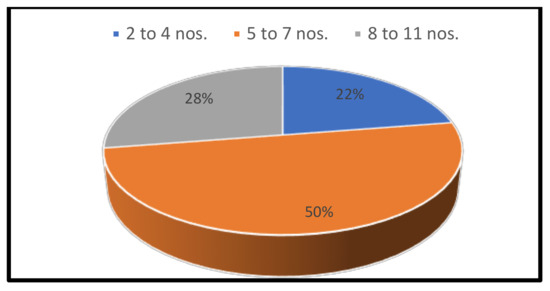
Figure 11.
Family size of the seed farmers.
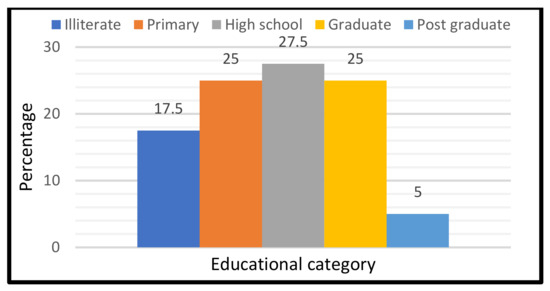
Figure 12.
Educational background of the seed farmers.
Average vegetable seeds farming land 44% was owned and irrigated land and 38% was tenant and irrigated land, which means farmers prefer to use land either owned or rental, but irrigated (Figure 13). With changes in the economic status of vegetable farming after adopting vegetable seed farming, the necessity of basic needs has changed markedly. As shown in Figure 14, the necessity for basic needs was lower, meaning income has increased. For medical expenditure, although the percentage of “not enough” was almost the same as before. The situation for education has not improved after adopting vegetable seed farming. There were no significant changes in “Luxury items” or “Savings”. An analysis of the profits and losses of selected vegetable seeds showed that 2019 was profitable for most vegetable seed production (Figure 14).
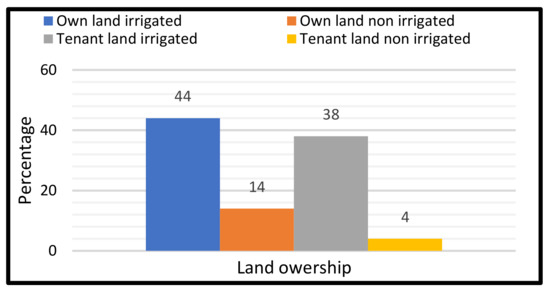
Figure 13.
Vegetable seeds farming land details.
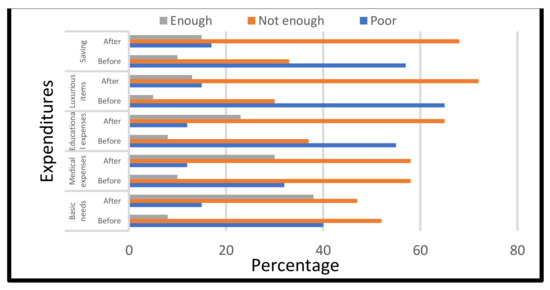
Figure 14.
Changes in economic status of the vegetable seed farmers.
Here, profit-loss analysis was done based on manpower recruitment excluding private business (Table 3, Table 4 and Table 5). Only cauliflower and broccoli seeds incurred losses during production, further revealing that vegetable seed cultivation was profitable if external factors remained the same (Figure 15). Most farmers cultivate various vegetable seeds, so if one vegetable incurs a loss, the seeds of other vegetables help to balance overall income. A comparison of the economics of the production of hybrid and open-pollinated variety seeds showed that hybrid seed production is more profitable to farmers [15].

Table 3.
Average manpower costs for nursery management (AMCNM).

Table 4.
Average nursery management cost (ANMC).

Table 5.
Profit or loss calculation of selected vegetable seeds.
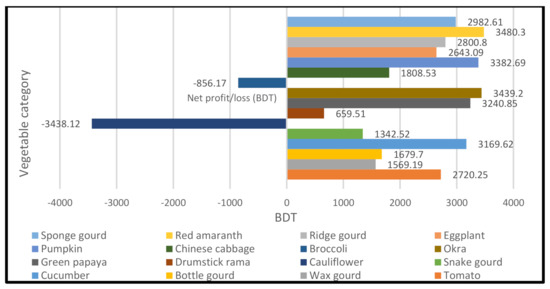
Figure 15.
Profit or loss of selected vegetable seeds.
Profit-loss analysis of vegetable seeds farming
Figure 16 shows the satisfaction level of seed farmers with the price of the vegetable seeds they sold in 2019. According to the farmers, the price of the seeds was fair (45%). Here, the satisfaction level with the price and economic situation of the farmers is a little contradictory because the economic situation has not changed to satisfactory for the vegetable seed farmers. The price of vegetable seeds mostly depends on the season. The bargaining power of the seed farmers was the following significant factor that can govern the price of vegetable seeds (Figure 17).
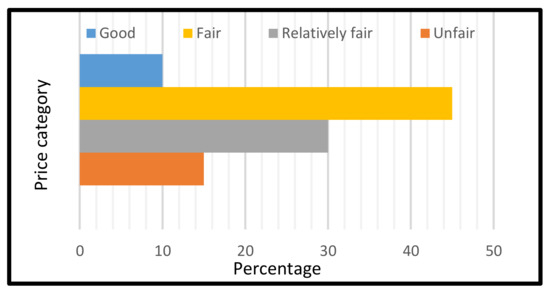
Figure 16.
Satisfaction level with the selling price.
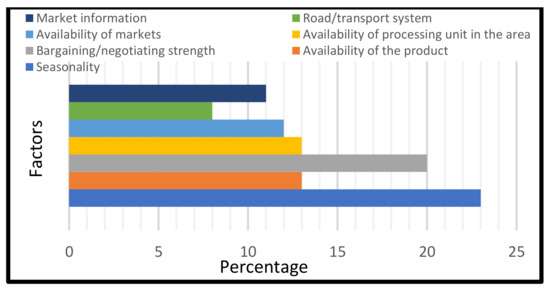
Figure 17.
Factors affecting the seed price.
For vegetable seed farming, unskilled labor availability was higher than family labor or hired skilled labor (Figure 18). Also, those workers were available locally. Their standard is not as poor as it is, as the majority of responses were pleased with a variety of labors. Unskilled labor mobility can be considered important for developing countries like Bangladesh, in search of regional economic integration [16].

Figure 18.
Labor supply situation.
Figure 19 reveals that collectors/traders played a major role in determining the price of vegetable seeds, indicating that the difficulties seed farmers face in the vegetable seed market were because the seed farmers cannot set the seed price due to the involvement of the traders. Other organizations such as cooperatives and the government cannot play a role in controlling the price because of the middlemen. Collectors try to control the seed price through their extensive networks. The collectors go to the rural areas of Bangladesh and directly collect seeds from the farmers. Because of the weak transportation infrastructure and limited scale of seed processing, companies typically avoid going to those regions. At present, only 39% of the rural population in Bangladesh has access to all-season roads [17].
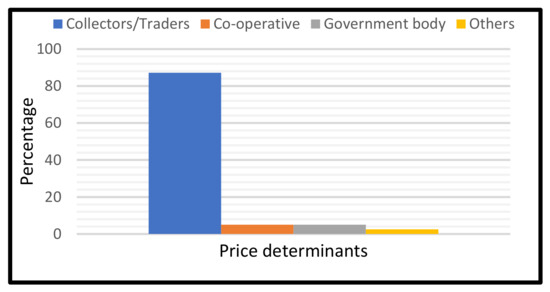
Figure 19.
Major players determining the price of seeds.
Figure 20 shows that the number one constraint for vegetable seed farmers was the road and transport system. The two other major constraints were seed processing units plus technical knowledge and support services, which are related to each other. Most of vegetable seed farmers use a traditional seed processing system to preserve seeds, and because they do not have modern processing units, it affects the transportation system. There is also a risk that in transforming old varieties into recognized varieties, the farming communities that developed the old varieties could, in a worst-case scenario, be prevented from continuing their traditional ways of storing and sharing seeds [18].
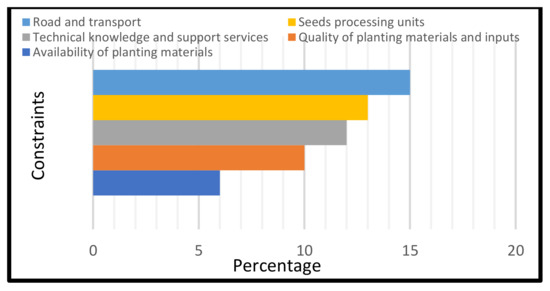
Figure 20.
Major constraints.
Figure 21 shows that the majority of the seeds were sold wholesale and dispersed throughout the country. The remaining variables, such as retailer seed, were all sold in the same terri-tory. Collectors often have a tendency to sell in the same region. It indicates that seeds are scarce in other districts where vegetable seed farming does not occur. As a result, the cost of seeds in another location is higher than in farming areas.
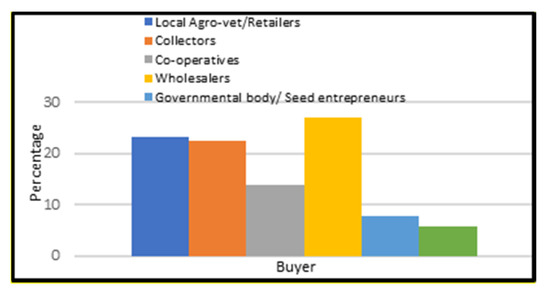
Figure 21.
Buyer of vegetable seeds.
Figure 22 shows that 37.5% of the vegetable seed farmers felt that vegetable seed farming was risky but profitable. Bangladesh, with its fertile lands and 180 million people in a small country, seems to offer the potential for vegetable seed farming, even though there are many obstacles. The amount of farmland has decreased because of the high population density, and vegetable seed farming is more profitable compared with crop farming [19], which indirectly means that whatever the situation is with vegetable seed farming, farmers will continue to do the same job. Recently in Bangladesh, the rapid growth in farm incomes and labor productivity has made it more attractive for workers to stay in agriculture [20].
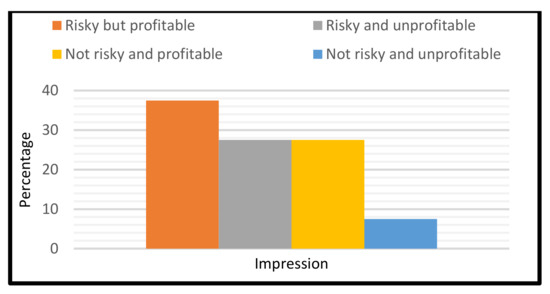
Figure 22.
Overall impression of farming.
Cash and credit are the most popular forms of funding for vegetable seed farmers. As a result, vegetable seed farmers like both options, and those service providers gave them the versatility. In contrast to service providers and vegetable seeds, the farmer has a positive relationship with and trustworthiness in credit transactions. Farmers of vegetable seeds, on the other hand, tend to do business in cash (Figure 23). It reveals the ability of vegetable seed farmers to harvest vast quantities of seeds. Sixty percent of vegetable seed farmers wanted to increase their production under certain circumstances, implying that growing vegetable seed is a lucrative enterprise, or that vegetable seed farmers want to do this business because it is an inherited business (Figure 24). They have been involved in the seed-producing industry for generations, and as a result, they did not have any other skills to switch careers.
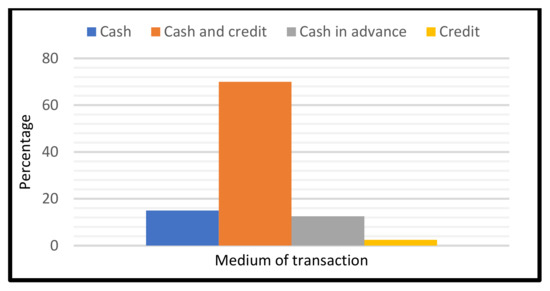
Figure 23.
The preferred medium of transaction.
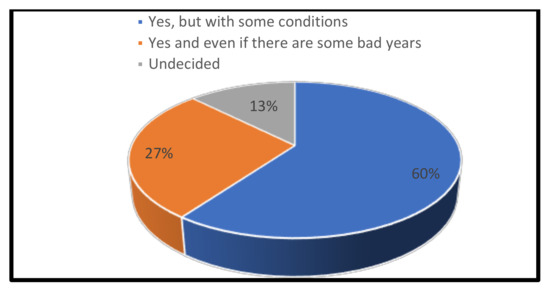
Figure 24.
Willingness to produce seeds in large quantities.
Figure 25 shows that technical knowledge and support services were the main problem in vegetable seed farming. Accordingly, most vegetable seed farmers desired direct government support and subsidies to help run their businesses. The second major problem was natural disasters, because Bangladesh has a flat topography, is low-lying, and has the biggest river delta in the world. To minimize losses stemming from natural disasters, most farmers wanted active government support such as weather forecasts and timely warnings of impending disasters. After a natural disaster, quick rehabilitation is necessary. The third major problem was the availability of planting materials and inputs. Most farmers want the creation of a cooperative society that will advise them about obtaining good quality planting and input materials at a cheaper price. Farmer organizations in the name of different cooperative societies are not new to Bangladesh, and such types of organization have been involved in a few agricultural products [21]. However, seed cooperative societies are not prevalent in Bangladesh. The proposed supply chain management system shown in Figure 26 could be a good solution for changing the current distribution system. Previously, cooperative societies have not been strongly active in the supply chain. Therefore, change in the system can come about by having a collection center as a part of a cooperative society and making it autonomous to control the seed production and marketing system all over the country.
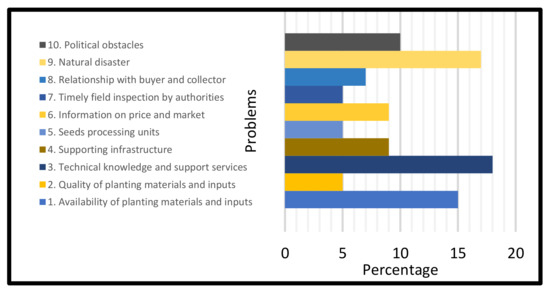
Figure 25.
Problems with vegetable seed farming.
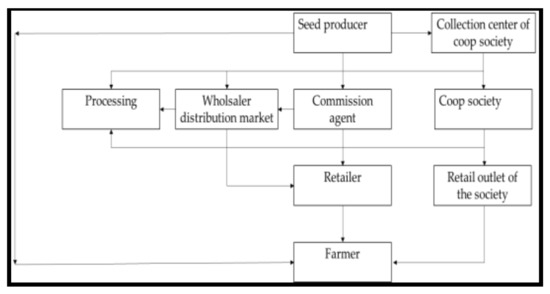
Figure 26.
Proposed supply chain system for vegetable seeds.
4. Discussion
This study revealed that in Bangladesh the vegetable seed sector requires more government support, especially in marketing policy, to change the current situation of vegetable seed farming. In particular, coordination between the private and public sectors is very important, and government monitoring of private organizations would benefit seed farmers and private companies. The Bangladesh seed sector needs cooperative societies that have their decision-making power. The government could encourage the establishment of farmers’ cooperatives to ensure a fair price for their products. However, the cooperatives should not be run as commercial profit-making entities [22]. All areas of Bangladesh would be connected with a cooperative society, so seed breeding and marketing quality would be the same.
Vegetable seed growers should receive more economic benefits. However, farmers are not able to produce vegetable seeds sufficiently at their discretion. Lack of technology, information, and funding are decisive issues.
Considering the current infrastructure conditions, the existence of middlemen cannot be denied, but improving the economic environment in which farmers can work on vegetable seed production at their discretion and improving the bargaining power of farmers in terms of purchasing materials and selling is necessary. Therefore, farmers have no choice but to produce according to the instructions of the middlemen, which also leads to seed quality issues.
5. Conclusions
According to the findings of the report, Bangladesh’s current vegetable seed marketing scheme is not up to the mark. Young and middle-class farmers and retailers are mostly interested in the vegetable seed marketing system. Bangladesh’s government began focusing more on the seed sector after the year 2000, with farmers and retailers joining the Bangladesh Society of Seed Technology (BSST). The transportation sector is most costly to both farmers and retailers. After doing seed farming and retail business, economically they are not profitable and do not change in their living standard. Farmers were able to collect workers locally, with which they were quite satisfied. But farmers were not satisfied with their vegetable seed selling price. Seasonality is one of the big factors as Bangladesh is a monsoon-based country. In the rainy season, the road transportation system becomes collapsed. Transportation networks eventually became a big issue in the seed marketing. Despite the numerous challenges that come with growing and selling vegetable seeds, they want to expand their farm and market. Farmers and retailers tend to do business in cash and continue doing business regardless of the situation. Existing seed distribution systems are unable to ensure a consistent supply of vegetable and fruit seeds at set prices throughout the country. The research focused on various vegetable seed processing and marketing processes in three of the eight divisions. This study leads us to conclude that it is necessary to form cooperative organizations for technical study and information exchange between farmers. The bargaining power of the farmers at the time of purchasing and selling production materials and solving the shortage of funds. Government assistance and coordination are also necessary. Along with that, these findings would aid the development of the vegetable seed distribution system of Bangladesh in further study. This study revealed that a large number of laborers were used from vegetable seed production to the collection hubs. The development of infrastructure is a key factor to making the vegetable seed business attractive and profitable. As well as a governing body, new marketing structures should be launched with strong cooperative societies, which would be an autonomous body under government auspices.
Author Contributions
Conceptualization, S.M. and A.N.; methodology, S.M.; software, S.M.; validation, S.M., A.N. and M.I.; formal analysis, S.M.; investigation, S.M.; resources, S.M., A.N. and M.I.; writing—original draft preparation, S.M.; writing—review and editing, A.N. and M.I.; visualization, S.M.; supervision, A.N. and M.I.; project administration, S.M., A.N. and M.I.; funding acquisition, S.M., A.N. and M.I. All authors have read and agreed to the published version of the manuscript.
Funding
This research received no external funding.
Institutional Review Board Statement
Not applicable.
Informed Consent Statement
Not applicable.
Data Availability Statement
Not applicable.
Acknowledgments
We thank The United Graduate School of Agricultural Sciences, Ehime University.
Conflicts of Interest
The authors declare no conflict of interest.
References
- Negi, S.; Anand, N. Issues and challenges in the supply chain of fruits & vegetables sector in India: A Review. Int. J. Manag. Value Supply Chain. (IJMVSC) 2015, 6, 47–49. [Google Scholar]
- MOA (Ministry of Agriculture). The National Seed Policy; Ministry of Agriculture in Bangladesh: Dhaka, Bangladesh, 2015.
- Khalon, A.S.; George, M.V. Agricultural Marketing and Price Policies; Allied Publishers Pvt. Ltd.: New Delhi, India, 1985; p. 3. [Google Scholar]
- Negasi, M.Y. Marketing system analysis of vegetables and fruits in Amhara regional state: Survey evidence from Raya Kobo and Harbu Woredas. Ethiop. J. Econ. 2016, 24, 1–3. [Google Scholar]
- Kolady, D.E.; Awal, M.A. Seed industry and seed policy reforms in Bangladesh: Impacts and implications. In International Food and Agribusiness Management Review; Wageningen Academic: Dhaka, Bangladesh, 2017; pp. 990–991. [Google Scholar]
- Dinrifo, R.R. Quality, Production and Export of Agricultural and Food Commodities in Nigeria; Agricultural Engineering Department: Ikorodu, Nigeria, 2015; Chapter II; pp. 221–222. [Google Scholar]
- OECD (Organization for Economic Co-operation and Development). Putting the Young in Business: Policy Challenges for Youth Entrepreneurship; OECD: Paris, France, 2001; pp. 44–45. [Google Scholar]
- Josep, V.; Sandra, S. Uses and Attitudes of Young People toward Technology and Mobile Telephony; IESE Business School-Universidad de Navarra. In Proceedings of the 16th Bled eCommerce Conference eTransformation, Bled, Slovenia, 9–11 June 2003; pp. 1–3. [Google Scholar]
- ASTA. Retailers Guide for Proper Handling & Storage of Lawn Seed Products; American Seed Trade Association: Alexandria, VA, USA, 2008; pp. 3–4. [Google Scholar]
- Watanabe, M. Middlemen: The Bid-Ask Spread; Department of Economics, Universidad Carlos III de Madrid: Calle Madrid, Getafe, Spain, 2006; pp. 2–3. [Google Scholar]
- Kalam, A. Application of Marketing Approaches to the Seed Marketing in Bangladesh: A Study on Dinajpur District; Hajee Mohammad Danesh Science and Technology University: Dinajpur, Bangladesh, 2016; pp. 40–41. [Google Scholar]
- Sandika, A. Impact of Middlemen on Vegetable Marketing Channels in Sri Lanka; University of Ruhuna: Kamburupitiya, Sri Lanka, 2011; pp. 58–59. [Google Scholar]
- Headey, D.; Bezemer, D.; Hazell, P.B. Agricultural Employment Trends in Asia and Africa: Too Fast or Too Slow? The World Bank Research Observer: Washington, DC, USA, 2010; Volume 25, No. 1; pp. 65–66. [Google Scholar]
- FAO (Food and Agriculture Organization). The Role of Women in Agriculture. Closing the Gender Gap for Development; FAO: Rome, Italy, 2011; pp. 47–49. [Google Scholar]
- Tomar, B.S. Seed Production: An Entrepreneurial Venture; Seed Production Unit, Division of Seed Science and Technology, IARI: New Delhi, India, 2011; pp. 8–9. [Google Scholar]
- Rahman, S. Impact of Rural Infrastructure on Farm and Non-Farm Enterprise Choice and Income in Bangladesh; Plymouth University: Plymouth, UK, 2014; pp. 287–288. [Google Scholar]
- CABI. Good Seed Initiative; A Strategy for CABI-Led Work on Seed Systems in Sub-Saharan Africa and South Asia; CABI: Wallingford, UK, 2014; pp. 21–22. [Google Scholar]
- MacRobert, J.F. Seed Business Management in Africa; CIMMYT: Harare, Zimbabwe, 2009; pp. 48–49. [Google Scholar]
- Hazell, P.B.R. Transforming Agriculture: The Green Revolution in Asia; International Food Policy Research Institute: Washington, DC, USA, 2009; pp. 14–16. [Google Scholar]
- Islam, K.K. Evolving and Strengthening the Cooperative Approach for Agroforestry Farmers in Bangladesh: Lessons Learned from the Shimogo Cooperative in Japan; Kyushu University: Fukuoka, Japan, 2018; pp. 2–17. [Google Scholar]
- Mondal, M.H. Crop Agriculture of Bangladesh: Challenges and Opportunities; Bangladesh Agricultural Research Institute (BARI): Gazipur, Bangladesh, 2010; pp. 243–244. [Google Scholar]
- Mustafa, A. Agricultural Unskilled Labor Mobility: Does It Matter? Kırıkkale University, Department of Economics: Kırıkkale, Turkey, 2003; pp. 1–2. [Google Scholar]
Publisher’s Note: MDPI stays neutral with regard to jurisdictional claims in published maps and institutional affiliations. |
© 2021 by the authors. Licensee MDPI, Basel, Switzerland. This article is an open access article distributed under the terms and conditions of the Creative Commons Attribution (CC BY) license (https://creativecommons.org/licenses/by/4.0/).